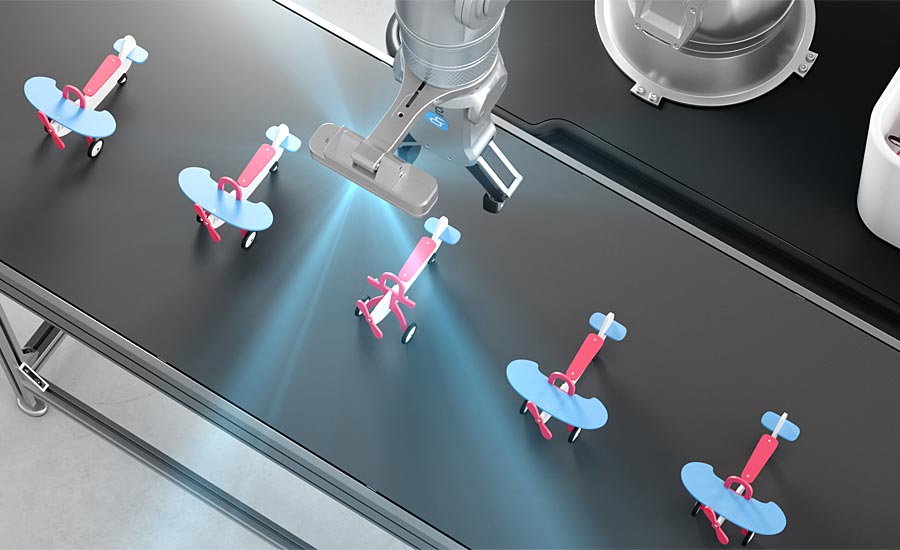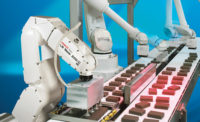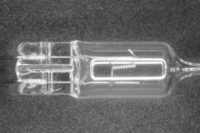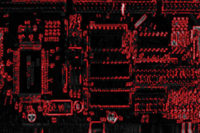The days when only large companies could adopt automation are long past. Collaborative robots (cobots), lightweight industrial robot arms (LIRAs) and affordable peripherals such as vision systems and grippers have created a new paradigm by making low cost, easy to use automation solutions available to small-to-medium sized companies for the first time.
Transforming Industrial Automation
Cobots and LIRAs are not as fast and powerful as traditional industrial robots, but they are much easier to use, highly efficient, and come at a fraction of the cost, making them a great fit for a whole host of applications from machine tending, metrology and assembly to screwdriving, visual inspection and packaging and palletizing. Ease of use is an important factor for manufacturers: Instead of having to call in robot experts every time they need to switch product or set up a new application, companies are now able to manage programming in-house, which means major savings in engineer costs and downtime.
Adoption rates indicate that industry is enthusiastic about the overall cobot proposition. According to the International Federation of Robotics, cobots are the fastest growing segment of the industrial robotics sector, growing at a rate four times faster than that of traditional industrial robots. Analyst firm Emergen Research predicts that cobot sales will climb to $9.3 billion by 2027, up from $0.7bn in 2019.
Emerging ‘Collaborative Applications’
The new paradigm isn’t just about lower cost, easier to use industrial automation, however. Cobots and LIRAs have a small footprint, which makes them highly mobile, flexible and easy to redeploy from one task to the next. This means that automation can be deployed without having to redesign large parts of your facility. Crucially, following a routine risk assessment, cobots and LIRAs can safely be deployed next to humans without the need for extensive safety fencing and guarding.
This combination of factors has spurred the emergence of ‘collaborative applications’ –cobot/LIRA-based industrial applications that allow humans and robots to safely and effectively collaborate in the same workspace. Collaborative applications are truly transformative in terms of the way automation is deployed in real-world settings.
Whereas traditional industrial robots present a stark either/or that forces companies to choose between human labor and automation, cobots and LIRAs provide a way for companies to make the most of their robot investment –24/7 availability, repeatability, accuracy— while retaining their versatile, problem-solving human workers. At the same time, collaborative application deployments free workers from the most tedious, repetitive and un-ergonomic aspects of their job.
The idea that human-robot teams provide the best of both worlds is backed up by a 2019 research study published in the International Journal of Advanced Manufacturing Technologies which found that cooperation between humans and machines can produce better results than just human or just robot teams alone.
From the perspective of manufacturers and industry in general, cobots and LIRAs hit that sweet spot between cost, complexity and functionality, making them an attractive proposition for all sorts of automation deployments.
Adding Vision To Collaborative Quality Applications
Of course, LIRAs and cobots need vision systems, grippers and related peripherals to effectively perform quality-related tasks such as material handling, visual inspection and object recognition. But what type of vision systems are best suited to the widest range of collaborative applications?
To answer this question, it’s important to understand the difference between the three main types of vision system –2D, 2.5D and 3D.
2D cameras are the cheapest, but also the least versatile. 2D cameras are able to determine length and width (X and Y axis), but cannot determine height, which limits the number of applications they can support.
At the other end of the spectrum are 3D cameras. These systems provide your robot with visual information across all three axes, including object rotation. 3D cameras offer high-powered functionality, but they are also the most expensive cameras. They also tend to be complex devices that are difficult for non-experts to integrate with their robots. Additionally, 3D cameras have reliability issues that make many manufacturers reluctant to embrace the technology, despite its functionality.
2.5D cameras occupy a sweet spot between 2D and 3D, both in terms of cost and capabilities. Capable of determining the height of objects, 2.5D cameras are ideal for scenarios in which objects differ in height and when items need to be stacked. Considerably less expensive than their 3D counterparts and considerably more capable than 2D cameras, 2.5D cameras are an ideal fit for a wide range of collaborative applications. 2D and 3D cameras have their place in quality applications, but the former offer limited functionality and more often than not, implementing 3D systems amounts to expensive and overcomplicated overkill.
Just as cobots and LIRAs offer a way to automate without the cost and complexity associated with traditional industrial robots, 2.5D-based vision systems offer a way to introduce highly capable machine vision to your automation deployment without all the cost and complexity associated with 3D-based vision systems.
However, not all 2.5D vision systems are created equal. So, if you have decided to implement a 2.5D system for collaborative quality applications on your cobot or LIRA, keep the following considerations around functionality, cross-compatibility and flexibility in mind.

The ‘Eyes’ vision system combines 2.5D camera technology with ease of use. The system is ideal for sorting a wide variety of objects, vision inspection, CNC machine tending and other pick-and-place applications. Source: OnRobot
Seeking Quality-Specific Functionality
Before you start using your camera, it needs to be calibrated. With many systems this is a complex and time-consuming process. So, look for systems that provide one-shot calibration as this will dramatically lower the barriers to a successful deployment.
A common quality task involves inspecting objects using color and contour detection to ensure consistent product quality, such as checking Insert Multi Mesh (IMM) parts for excessive or inadequate material after the part has been molded. Make sure to seek out 2.5D systems that provide software with easy to implement, built-in color and contour detection functionality, as this will enable your robot to easily sort, inspect, or pick and place unstructured objects, based on simple color and size information input by the operator.
Cross-Compatibility
To make the most of your vision system investment, look out for 2.5D systems that are compatible with a wide range of leading cobot and LIRA brands. This cross-compatibility will ensure that your vision system remains viable even if you decide to change your cobot or LIRA at some point in the future. Additionally, look for systems that provide plug & play compatibility with your cobot/LIRA, as this will further simplify the deployment process.
Flexibility
One of the most compelling features of cobots and LIRAs is the ease with which they can be deployed and redeployed. In real-world scenarios, this makes them much more flexible than their traditional industrial robot counterparts. With this in mind, look for 2.5D vision systems that provide matching levels of flexibility.
For example, some systems are integrated directly with your robot’s arm or will only function when mounted on your robot’s wrist. This restricts their overall capabilities. To support the widest range of collaborative applications, look for 2.5D vision systems that can be mounted externally. Such systems provide greater freedom, because they enable your camera to be mounted anywhere within the production cell. Furthermore, external mounting eliminates the issue of cables running alongside your robot.
External mounting also provides an opportunity to optimize cycle times, because the camera can take care of image capture and processing while your cobot/LIRA is working on another operation. Some 2.5D systems can even be used to support manual quality inspections. In such scenarios, the operator sets up a camera and inspection program, manually places the workpiece, and then executes inspection without a robot.
For the same reasons that cobots and LIRAs hit the sweet spot between cost, complexity and functionality for many industrial applications, 2.5D systems hit the sweet spot for vision-based collaborative applications.



